The Sept. 3, 2003 news page had the first reader report of an end user actually receiving a Dual G5 system. I don't understand how an early July EDU order would ship before a day 1 order (several student readers said their day 1 order was delayed) but here's the first reader mail on a Dual 2GHz G5 actually arriving to an end user (i.e. not a College/institution):
"
Got my 2GHz DP G5 this morning. It was ordered on 7/3 through the edu channel.
It looks pretty funny sitting next to the old 'Gateway 2000' monitor
connected to it; a temporary situation...
Eric M.
"
I asked Eric if he could send a photo of the internals/run some real-world tests. (All the dual G5 results I've seen were from pre-production systems - not an actual shipped model.) I know many are going to think this is report is a hoax after having their day 1 orders (even EDU/student orders) delayed. Here's some of the photos he sent. (Quotes over the images are his.)
"An overview of the internals....Good lookin' organs"
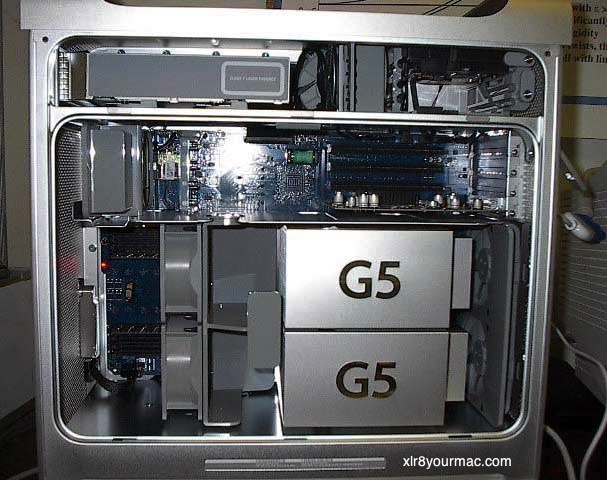
"The RAM slots....Those lonely modules certainly need some company"
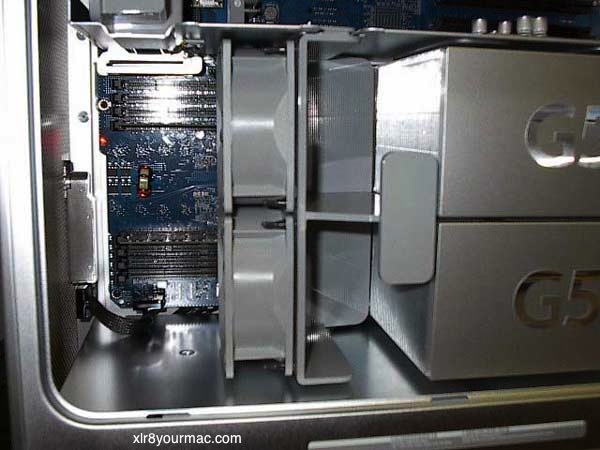
"The PCI compartment"
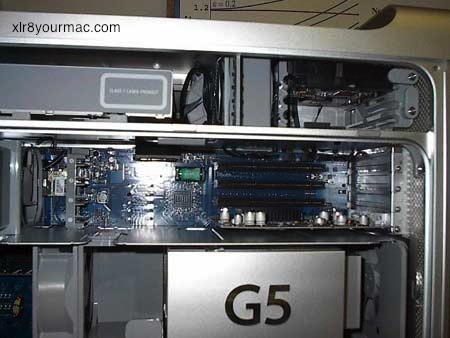
"A look at the heat sinks. There is certainly a large surface area to
volume ratio here.
Looks more like an industrial heat exchanger than a
CPU heat sink."
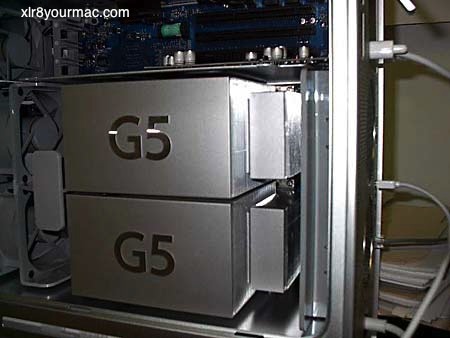
"I found this a little odd. There are four screws attached to the drive
bay
fan enclosure that do nothing as far as I can tell."
(I suspect they may be
spare screws for use when you add a 2nd hard drive perhaps,
although they look a bit large for that. (Turns out the screw heads
are guides for the drive in the grooves.))
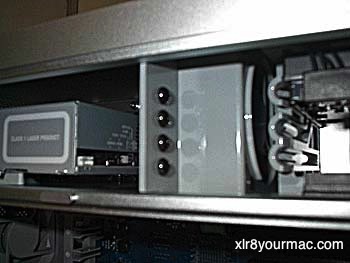
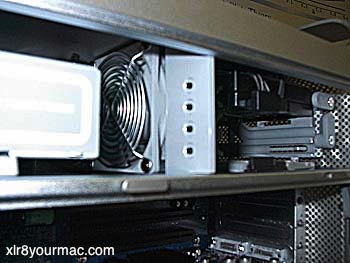
Note: The 4 large screws are for a 2nd hard drive. They screw directly into the drive and are used as guides/supports in the drive bay channels. (See the G5 Tech Docs/Info page here for links to
Apple's G5 CIP page which has guides to installing drives, cards, and more.)
He also sent some initial test results. I later wrote to ask if he had run Software Updates (in case there were any updates specific to the G5 since the build). He had commented that "Other than the developer tools and X11, it's a clean OS".
Here's his system details from an ASP report:
(Standard Dual G5 config.)
- 512MB RAM (two 256MB dimms)
- Pioneer DVR-106D firmware A606
(Note - several single G5s have been reported
as having an OEM Sony DW-U10A drive. Both
normally support DVD+R/+RW also, but
may not with Apple OEM firmware.)
- OS X 10.2.7 (build 6S80)
- 160GB Hard Drive (Seagate ST3160023AS)
(Seagate specs show 7200RPM/8MB cache, 8.5MS avg seek)
- ATI 9600 Pro/64MB (ID: RV350, ROM: 113-A13601-120)
I guess 10.2.7 adds native support for the DVR-106 drive (Panther betas were already reported
as supporting it.) I asked if he could try a DVD+R or DVD+RW disc to see if the OEM Apple drive supported that media (the retail DVR-106/A06 does)
"
I tested a Verbatim DVD+RW disk with no luck from the Finder or Disk Copy.
The OS recognized it as a blank DVD and asked what to do with it. It
'mounted' in the Finder and allowed things to be 'copied' to it. But would
not burn. Attached is the error message (and is about as vague as a Windows
error message).
"Sorry, the operation could not be completed because an unexpected error occurred:
(Error Code -2147352509)."
I have Toast 5 but have not tried it. I'm assuming it will work. I'll let
you know.
Eric
"
Cinebench 2003 (v1) results: (NOTE: Scores in Italics are from a MDD Dual G4/1.25GHz w/9800 Pro card running 10.2.6)
****************************************************
Tester : EMM
Processor : PowerMac G5
MHz : 2000
Number of CPUs : 2
Operating System : 10.2.7
Graphics Card : Radeon9600Pro
Resolution : 1024 x 768
Color Depth : Millions
****************************************************
Rendering (Single CPU): 219 CB-CPU (Dual G4 1.25GHz/9800 = 120)
Rendering (Multiple CPU): 401 CB-CPU (Dual G4 1.25GHz/9800 = 220)
Multiprocessor Speedup: 1.83 (Dual G4 1.25GHz/9800 = 1.83)
Shading (CINEMA 4D) : 266 CB-GFX (Dual G4 1.25GHz/9800 = 149)
Shading (OpenGL Software Lighting) : 661 CB-GFX (Dual G4 1.25GHz/9800 = 411)
Shading (OpenGL Hardware Lighting) : 1168 CB-GFX (Dual G4 1.25GHz/9800 = 875)
OpenGL Speedup: 4.40 (Dual G4 1.25GHz/9800 = 5.87)
****************************************************
iMovie DV->QT (CDROM size) Export Tests:
"Using the five iDVD clips (which I imported into iMovie) instead of the six
iMovie clips took 88 seconds. The total video length was 1:36:17.
(he later wrote)
Got the (iMovie tutorial) files off an eMac.
It took 40 seconds (exactly) to export the six
clips.
Eric"
iMovie to date does not seem to take advantage of dual CPUs as shown in past
CPU Upgrade reviews comparison tests here, but I was curious as to how the G5 would compare.
For reference a 1.467GHz G4 upgrade in my Digital Audio system took 41.6 seconds for the iMovie tutorial export.
iTunes AIFF->MP3/AIFF->AAC Conversion from Hard Drive: These tests are from another reader that had access to a Univ. Dual G5 2GHz system. (Thanks Nick!)
"I work at a university, and our dual 2Ghz G5 just arrived. I just did
a quick iTunes benchmark, converting "Moment's Notice" (Coltrane) from
AIFF, on the hard drive:
I just watched for the highest reached conversion speed factor:
Dual 2Ghz G5:
converting to 160 MP3: 45.6x
converting to 160 AAC: 33.5x
My 12" PowerBook G4 867Mhz:
converting to 160 MP3: 11.5x
converting to 160 AAC: 8.8x
The G5 is standard factory configuration.
The PowerBook is running Panther 7B53.
Both systems had nothing but iTunes running, and were not playing the
tracks while converting them.
Nick M."
I asked Nick if he had access to a dual G4 system to run the same tests for comparison. (BTW - to the 6th grader that asked why Nick mentioned the song name - that's in case anyone else wanted to duplicate his test with the exact same song. (Different songs can be a different filesize/length etc. and of course different file sizes will result in different results/times to convert.)
He later sent more test results:
"
I ran one of the tutorials for the molecular dynamics code GROMACS on
the G5 and my old G4 500DP (Mac OS X 10.2.6).
I compiled the code using gcc on both machines (I haven't got it to
compile with xlc). I used the default flags as determined by configure.
Eric
G5:
Computing: M-Number M-Flop's % Flop's
LJ 38.060171 1179.865301 1.5
Coulomb 97.815325 2641.013775 3.3
Coulomb(W) 6.783280 549.445680 0.7
LJ + Coulomb 61.862979 2350.793202 2.9
LJ + Coul(W) 18.950919 1743.484548 2.2
LJ + Coul(WW) 266.802340 65366.573300 80.6
Innerloop-Iatom 151.534110 1515.341100 1.9
NS-Pairs 92.286518 1938.016878 2.4
Reset In Box 1.373241 12.359169 0.0
Shift-X 27.415482 164.492892 0.2
CG-CoM 0.477453 13.846137 0.0
Angles 1.385277 225.800151 0.3
Propers 0.510102 116.813358 0.1
Impropers 0.450090 93.618720 0.1
Pos. Restr. 0.730146 36.507300 0.0
Virial 13.842768 249.169824 0.3
Update 13.707741 424.939971 0.5
Stop-CM 13.705000 137.050000 0.2
Calc-Ekin 13.710482 370.183014 0.5
Lincs 0.960576 57.634560 0.1
Lincs-Mat 16.629972 66.519888 0.1
Shake-V 13.707741 205.616115 0.3
Shake-Vir 13.707741 246.739338 0.3
Settle 4.252550 1373.573650 1.7
Total 81079.39787 100.0
NODE (s) Real (s) (%)
Time: 35.990 36.000 100.0
(Mnbf/s) (GFlops) (ps/NODE hour) (NODE hour/ns)
Performance: 74.358 2.253 1000.278 1.000
G4:
Computing: M-Number M-Flop's % Flop's
LJ 38.060171 1179.865301 1.5
Coulomb 97.815325 2641.013775 3.3
Coulomb(W) 6.783280 549.445680 0.7
LJ + Coulomb 61.862979 2350.793202 2.9
LJ + Coul(W) 18.950919 1743.484548 2.2
LJ + Coul(WW) 266.802340 65366.573300 80.6
Innerloop-Iatom 151.534110 1515.341100 1.9
NS-Pairs 92.286518 1938.016878 2.4
Reset In Box 1.373241 12.359169 0.0
Shift-X 27.415482 164.492892 0.2
CG-CoM 0.477453 13.846137 0.0
Angles 1.385277 225.800151 0.3
Propers 0.510102 116.813358 0.1
Impropers 0.450090 93.618720 0.1
Pos. Restr. 0.730146 36.507300 0.0
Virial 13.842768 249.169824 0.3
Update 13.707741 424.939971 0.5
Stop-CM 13.705000 137.050000 0.2
Calc-Ekin 13.710482 370.183014 0.5
Lincs 0.960576 57.634560 0.1
Lincs-Mat 16.629972 66.519888 0.1
Shake-V 13.707741 205.616115 0.3
Shake-Vir 13.707741 246.739338 0.3
Settle 4.252550 1373.573650 1.7
Total 81079.39787 100.0
NODE (s) Real (s) (%)
Time: 137.970 138.000 100.0
(Mnbf/s) (MFlops) (ps/NODE hour) (NODE hour/ns)
Performance: 19.397 587.660 260.926 3.833
PC Mag compares Dual G5 vs Dual G4 vs Dual 3GHz Xeon PC (Sept. 19th, 2003) PC Magazine has a review of the Dual G5 2GHz (www.pcmag.com/article2/0,4149,1274138,00.asp) that compares performance to a Dell Pecision 650 workstation with Dual 3GHz Xeon CPUs and a Dual 1.42GHz G4. You'll want to read all the pages (page 2 has apps test notes not on the results page) but the table of test results is on page 3. (The Avid Xpress Pro tests mentioned on page 2 are not listed on the results page however, at least not as of Sept. 20th.) Although they didn't mention it, hopefully they had the G5 Energy Saver set to "Highest" performance (see the power management/bus slewing note on the G5 Tech Docs page here about how this can affect cpu/bus speeds. Although it may have been running full speed in "Auto" mode during the tests, it's still preferred for performance tests to set it to highest performance.
PSBench7 (Photoshop7) G5 Results/Comparisons: (from the Sept. 17th, 2003 news page)
(from a reader mail, I've used PSbench in past reviews/tests but not yet run it personally on a G5)
"Over on the Ars forums Ps7Bench results for a dual G5 have been posted. They
are better than I thought they would be. Out front by a *very* nice margin.
Some of the PS pros say that some of the tests in this bench are hardly ever
used (e.g. watercolor filter). Hopefully a new PS bench will appear.
-ADDRAGYN
PS7Bench (www.geocities.com/sw_perf/PSBench.html)
Ars thread at
arstechnica.infopop.net/OpenTopic/page?q=Y&a=tpc&s=50009562&f=48409524&m=7760969205&p=36.
Scores (Normalized, higher score is better)
2x 2000 G5 OSX 10.2.7 (G5 plugin) 555 (energy settings highest perf)
2x 3060 Xeon (OC'd 2400) 488
2x 2930 Xeon (OC'd 2400) 471
3200 P4 (800MHz) 427
3000 P4 (800MHz) 405
3495 P4 (OC'd 3.06) 386
3060 P4 XP Pro (533 FSB) 358 HT
2x 2200 Xeon PC 800 RDRAM CPQ Evo 357 HT
2x 1500 G4 (OC'd 1420) 348
2x 1333 G4 DDR OS9.2 (oc'd 1.25) 346
1800 G5 OSX 10.2.7 (G5 plugin) 344 (energy settings highest perf)
2x 1420 G4 OSX 10.2.4 338
2x 2400+Athlon MP 338
2x 1250 G4 OS 9.2.2j 337
3200+Athlon XP 332
1800 Opteron(dual-chnlDDR 333) 332
2x 1333 G4 DDR OSX10.2.2(oc 1.25) 326
1800 OPteron(singl-chnlDDR333) 320
3000+Athlon XP 318
2x 1250 G4 OSX 10.2.5 318
2x 1250 G4 DDR OSX 10.2.1 316
2x 1800 Athlon MP 312
2800+Athlon XP Barton 298
2x 2000 P4 Xeon 286
2x 1200 G4Powerlogix(867MHzG4/QS) 285 upgraded
2x 1533 Athlon MP 285
2x 1533 Athlon MP 283
2530 P4 mobile (OC'd 1400) 282
2700 P4B (OC 2400, 600 MHz FSB)280
2x 1466 Athlon XP 279
1600 G5 OSX 10.2.7w/G5 Plugin 276 *MacNNscores
2666 P4 (DDR 333) 269
2x 1000 G4 DDR 10.2 267
2400+Athlon XP 262
2x 1000 G4 OS9 260
2x 1000 G4 OSX 10.1.5 254
2400+Athlon 252
2400 P4B (800MHz) 251
2400b (sis 648 DDR400) 251
1600 Centrino IBM T40 250
2400 P4 (533MHz bus) 249
2400 P4 B 241
2340 P4 (overclock) 239
1600 Centrino Dell D800 236
2400 P4 234
1800+Athlon XP (1533 MHz) 226
1577 oc'd Athlon XP (Lestat) 221
2x 1000 G4 OSX 10.2.2 (upgraded) 218 ?!(dual 533 logic board)
1548 Athlon XP 214
1670 Athlon XP (2000+) 213
1667 Athlon XP 211
1400 Athlon XP 1600+ xp pro 200
1x 1533 Athlon MP 197
1300 Centrino Sony VAIO Z1A 196
1000 G4 17" Powrbk OSX 10.2.6 196
2000 P4 Xeon 194
1400 Athlon XP 1600+'98SE 191
1000 G4 OSX TiPbk 10.2.2 185
2x 533 G4 OSX 10.1.5 175
2x 533 G4 OS 9.2.2 174
1800 P4 173
1200 AthlonMP 168
1508 Celeron (overclock) 167
1400 PIII Tualatin 160 **?
2x 550 G4 OSX 10.2.3 (OC Cube) 160 **?
2x 500 G4 OSX 152
2x 450 G4 OS9 151
1333 Athlon TBird 147
2x 450 G4 OSX 10.1.5 143
800 G4 Pbook OSX 1MB L3 135
733 G4 (miro7) 134
667 G4 PBk OS9 noL3 127
667 G4 PBk OSX 10.2.3 no L3 125
466 G4 OS9 123
667 G4 OSX TiPBk 10.1.5 noL3 121
866 PIII 114
466 G4 OSX 133 MHz bus 112
550 G4 Powrbk OS9* 104
500 G4 Pbook (OC'd 400) 103
1x 450 G4 OSX 100 MHz bus 101
1000 Athlon TBird (PS6.01) 100
550 G4 Powrbk OSX* 95
933 Transmeta Crusoe Sony 78
700 G3 iBook 74
600 G3 iBook OS 9.2.2j 70
233 PII 30
MW G5 Comparison Tests: (from the Sept. 12th, 2003 news) Macworld posted a page with some tests of each of the G5 models at www.macworld.com/2003/09/reviews/macworldlabfirstg5testresults/. Macaddict also posted their initial benchmarks of a Dual G5 2GHz later that day, limited initially to just a QT/DV to MPEG4 tests (similar to my upgrade review tests) and some Photoshop 7 filter tests. (I'm hoping they retest the other machines with 2GB of RAM in them as well as note how much memory was allocated to Photoshop.)
|